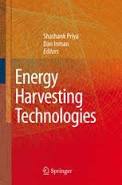piezoelectric backpack

Piezoelectric Backpack Concept: Take a Walk, Charge Your Gadgets All that rubbing of your backpack straps on your shoulders may now be put to good use, thanks to straps made of piezoelectric fabric that can convert the friction on your shoulders to electric energy. If solar-powered bags aren't your thing, engineers from Michigan Technological University, Arizona State University and NanoSonic Inc. have you covered, having developed a concept backpack that "harvests" the energy created by the friction of a bouncing backpack.The straps, made from polyvinylidene fluoride (PVDF) -- a strong, flexible material that feels similar to nylon -- generate an electrical charge from applied stress, sort of like when you rub your feet on the carpet and shock your little brother; in this case, though, the energy can be used to keep rechargeable gadgets like iPods and cell phones charged up. The developers estimate that when shouldered with a 100 pound load -- a typical pack weight for soldiers, for whom the pack was first devised -- and walking at 2-3 mph, the straps could generate 45.6 milliwatts (mW) of power.

This power output could either be used to power small electronics, or be accumulated in a small battery pack; some devices that could be "plugged in" to the pack are an LED headlamp (~38 mW), an iPod nano (~46mW), and a Motorola Razr cell phone, which in standby requires ~9 mW of continuous powering and ~360 mW during talk mode.According to Henry Sodano, one of the device's developers, from Arizona State University, "In general, we want to accumulate the power before using it so that we could walk for 20 minutes then talk for 2.5 minutes. Or you could charge an LED headlamp while you walk in the day and use it at night while you camp. The energy could also go toward powering a handheld GPS system, which requires ~165-200 mW of continuous power." So long, bulky chargers and heavy batteries.The military is likely to get the first crack at this technology, while developers continue to work on integrating piezo textiles into other conventional outerwear; imagine what sort of fun you could have with a combination piezo/solar backpack!

For more piezoelectric action, check out Japan: Producing Electricity from Train Station Ticket Gates and Solar Powered Retinal Implants. ::Physorg via ::Cool HuntingThe energy harvesting backpack uses piezoelectric straps to generate electrical energy.
koenigsegg backpackCredit: Jonathan Granstrom, et al.
supreme backpack 14ss All that rubbing of your backpack straps on your shoulders may be put to good use, now that researchers have designed a novel type of energy harvesting backpack.
backpack ticking memeThe pack has straps made of a piezoelectric material that can convert the mechanical strain on the straps into electrical energy that may power or recharge portable electronics.
muji backpack malaysia
The piezoelectric backpack straps are the latest innovation in the area of “energy harvesting,” where otherwise-wasted, ambient energy is converted into electrical energy to prolong the life of electronics. Mechanical engineers Jonathan Granstrom and Joel Feenstra from Michigan Technological University, Henry Sodano from Arizona State University, and Kevin Farinholt from NanoSonic, Inc., have published their results in a recent issue of Smart Materials and Structures.
backpack ac2 The group’s intentions in designing the energy harvesting backpack were to make a device that was transparent to the user by not interfering with the user’s flexibility or endurance, as well as providing enough energy to reduce the need for carrying heavy batteries to power portable electronics.
z40 backpack“The strap would operate no differently than the strap on a traditional backpack.”
piezoelectric backpack
The backpack uses straps made of polyvinylidene fluoride (PVDF), a strong, flexible material that feels very similar to nylon. But unlike nylon, PVDF is piezoelectric, meaning that an applied stress generates an electrical charge. When carrying a 100-pound load—a typical amount for a solider’s pack—and walking at 2-3 mph, simulations showed that the straps could generate 45.6 mW of power. The researchers said that this power output could either be used to power small electronics, or be accumulated over the duration of an excursion to be used as a weightless supplemental energy source instead of carrying extra batteries. “Some devices that could be powered include an LED headlamp (~38 mW), an Ipod Nano (~46mW), and a Motorola Razr cell phone, which in standby requires ~9 mW of continuous powering and ~360 mW during talk mode,” Sodano said. “In general, we want to accumulate the power before using it so that we could walk for 20 minutes then talk for 2.5 minutes.

The energy could also go toward powering a handheld GPS system, which requires ~165-200 mW of continuous power.” One of the biggest challenges in designing the straps was finding an extremely robust and durable electrode, since typical electrodes cannot tolerate the high levels of strain imposed by the straps. The researchers teamed up with a company in Blacksburg, Virginia called NanoSonic, Inc., that provided a self-assembled nanocomposite material called “Metal RubberTM” to tailor an advanced electrode. Using nanotechnology to control its macroscopic properties, the researchers fabricated a 100-nm-thick electrode that could undergo strains of 1000% while maintaining conductivity, and then return to its original shape when released. The researchers hope that additional energy harvesting systems can be also be seamlessly integrated into a user’s normal gear, perhaps based on the piezoelectric backpack straps. Citation: Granstrom, Jonathan, Feenstra, Joel, Sodano, Henry A., and Farinholt, Kevin.